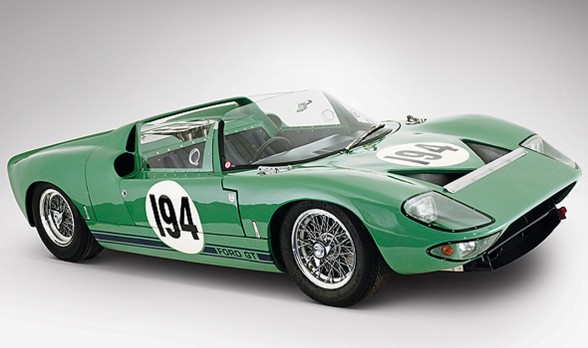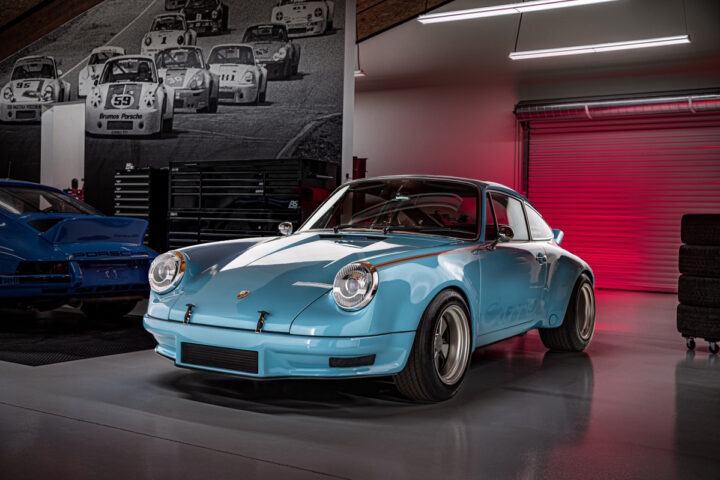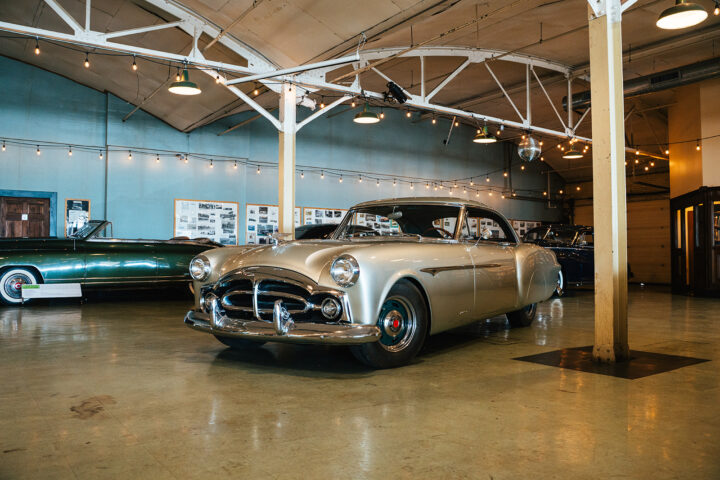TGR Staff
Only five prototypes of the open GT Roadsters were built by Ford Advanced Vehicle Operations in the United Kingdom in 1965. Of the units that were built, only four have survived. This particular Ford GT Works
Prototype Roadster with chassis number “GT/111? was first tested at the
1965 Le Mans trials by John Whitmore before it was fielded as a Works entrant in the Targa Florio. Painted in Linden
Green and with Whitmore joined by Bob Bondurant as co-driver, the car ran as high as a third-place until it was forced to prematurely retire due to racing-incident-induced damage.
The car disappeared from the public’s eyes for the next 40 years. The chassis was recently rediscovered in 2006 with its authenticity confirmed by the world’s leading authorities on GT40s. Following a restoration, chassis number
“GT/111? reappeared on the race circuit in 2007 at the Goodwood Revival
and has since gone on to race competitively at some of Europe’s most
prestigious events.“The Ford GT represents one of the world’s most iconic sports car designs,” said Max Girardo, RM Europe’s managing director. “Joining power with beauty, it is the perfect fit for our debut
sale at the Concorso d’Eleganza Villa d’Este. As one of just four
surviving examples and one of only three to have been raced by the
Works, it presents an extraordinarily rare ownership opportunity for
discerning collectors, deserving of close inspection.”The Ford GT will
join the six Bertone-designed concept cars that will be auctioned off in
Italy.History of the Ford GT40
This Ford GT40 Roadster (GT108) was the first of the open cars completed in March of 1965. It was first delivered to Carroll Shelby shops and
tested at Silverstone by John Whitmore and Dickie Atwood, and by Ken
Miles at Riverside Raceway that year. The car was the official factory testbed for the ZF transaxle and resulted in all GT40s using the ZF from then on. From 1965 to 1992 the car was owned by George Sawyer, John Robertson and Tom Congleton. The car was restored for both Congleton and Robertson and successfully vintage raced through the 1980s and 90s. It is the
only intact example that still carries the correct 1965-style nose, and
the low tail section unique to roadsters. This car is also the only
roadster , or ‘Spyder‘, to remain in as-built condition. The history of
the Ford GT40 began as an attempt to beat a certain Italian Automobile
Manufacturer at the grueling 24 Hours of LeMans race. Each June, some of
the world’s best in the automotive industry descend onto a town West of
Paris called LeMans, France to compete in a 24-Hour endurance competition. This tradition began in 1923 and since has become the pinnacle of automotive racing that challenges speed, performance, and durability. A select group of European marques had since dominated the race such as Porsche, Ferrari, Jaguar, Bentley, and Alfa Romeo.
Ford
wanted to join this elite group. During the early part of 1960?s,
Ford attempted to buy Ferrari for $18 million to run its international racing program. The purpose was to use the Ferrari company and technology to help Ford achieve a LeMans victory. The negations unraveled and Ferrari walked away from the bargaining table in May of 1963.
Enzo Ferrari gave no indication as to why he had decided his company was no longer for sale. Ford decided to build their own super-car and beat
Ferrari at International Racing. Roy Lunn was an Englishman who had begun
his career at Ford of Britain and later came to the United States in
1958.
He had played a role in helping to create the 1962 mid-engined
Ford Mustang I Concept. The vehicle was an aluminum-bodied, two-seater
that was powered by a 1.7-liter 4-cylinder engine. After the Mustang I,
Roy Lunn along with Ray Geddes and Donald Frey turned their attention to a racing program. The car that Ford had conceived was similar to a Lola
GT, being low and mid-engined. The Lola was designed and built by Eric
Broadley in Slough, England and first displayed in January of 1963 at the London Racing Car Show. Broadley was running low on funds and consequently more than eager to join with Ford. Borrowed from the Lola GT
were the monocoque center section and aerodynamic design. It was longer,
wider, and stronger with a rigid steel section. In the mid-section lay an all-aluminum 4.2-liter V8 engine. The gearbox was a 4-speed Colotti unit; the suspension was double-wishbone. Excellent stopping power was provided by the 11.5-inch disc brakes on all four wheels. In April 1964
the GT40 was displayed to the public at the New York Auto Show. Two weeks later the car was at Le Mans being put through pre-race testing.
The result of a very rushed program became evident. The car suffered
from aerodynamic and stability issues and as a result ended in two
crashes.
The GT represented ‘Grand Turismo‘ while the designation 40
represented its height, only 40 inches. The number 40 was added to the
designation when the Mark II was introduced.The Mark II, still built in
England, was put through extensive testing which solved many of the
stability issues. Carroll Shelby was brought onboard to oversee the
racing program. He began by installing a 7-liter NASCAR engine that was
more powerful and more reliable. The result was a vehicle that was much
more stable and quicker than the Mark I. For the 1965 LeMans, the Mark
II proved to be a stronger contender but resulted in another
unsuccessful campaign.The third generation of the GT-40, the Mark III,
was introduced in 1966 and only seven were produced. Ford continued to
fine-tune and prepare the GT-40 for LeMans. The GT40 led the race from
the beginning. This lead continued throughout the evening and into the
morning hours. During the morning the GT40?s were ordered to reduce
their speed for purposes of reliability. By noon, ten out of the
thirteen Fords entered had been eliminated. The remaining three Fords
went on to capture first through third place. This victory marked the
beginning of a four-year domination of the race.
In 1967 Ford introduced
the Mark IV to LeMans. It was built all-American, where the previous
versions had been criticized as being English-built and fueled by
monetary resources from America. This had not been the first attempt for
an all-American team using an American vehicle to attempt to capture
victory at LeMans. Stutz had finished second in 1928. Chrysler had
finished third and fourth during the same year, 1928. In 1950 the first
major attempt to win at Lemans was undertaken by a wealthy American
named Briggs Cunningham. Using modified Cadillac’s he captured 10th and
11th. His following attempts to win at LeMans included vehicles that he
had built where he managed a third place finish in 1953 and fifth place
in 1954. This had been the American legacy at LeMans.Of the seven
vehicles Ford entered in 1967, three crashed during the night time
hours. When the checkered flag dropped it was a GT40 driven by
Gurney/Foyt to beat out the 2nd and 3rd place Ferrari by only four
laps.For 1968 the FIA put a ceiling on engine displacement at 5 liters.
Ford had proven that Ferrari could be beaten and an American team and
car could win at LeMans. Ford left international sports racing and sold
the cars to John Wyer. Gulf Oil Co. provided sponsorship during the 1968
LeMans season. The Ford GT40 Mark I once again visited LeMans and again
in 1969 where they emerged victorious both times. In 1969 the margin of
victory for the GT40 was just two seconds after the 24 Hours of
racing.In 1969 new FIA rules and regulations ultimately retired the
GT40?s from racing and ended the winning streak.Around 126 Ford GT-40?s
were producing during the production life span.
During this time a wide
variety of engines were used to power the vehicle. The MKI used a 255
cubic-inch Indy 4-cam, a 289 and 302 small block. The 289 was by far the
most popular, producing between 380 and 400 horsepower. When the MKI
returned during the 1968 and 1969 season it was outfitted with a 351
cubic-inch Windsor engine. The MKII came equipped with a 427 cubic-inch
NASCAR engine. The third generation, the MK-III, had 289 cubic-inch
engines. The final version, the MK-IV all were given 427 cubic-inch
power-plants.America, more specifically Ford, had proven that American
automobiles and drivers were able to compete in all arenas.After the
production of the Ford GT40 ceased, there were several companies
interested in creating replicas. One such company was Safir Engineering
which purchased the rights to the name. In 1985 the Ford GT40 MKV was
introduced and examples would continued to be produced until 1999.
Chassis numbers continued in sequence where the original Ford cars
stopped. The cars were powered by a Ford 289 cubic-inch OHV engine that
produced just over 300 horsepower and was able to carry the car to a top
speed of 164. Zero-to-sixty took just 5.3 seconds. Disc brakes could be
found on all four corners.
Source: RM Auctions






















